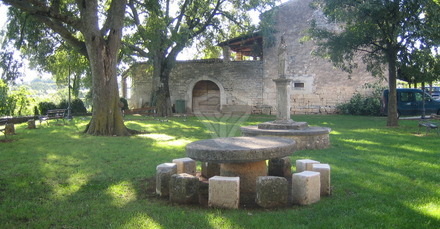to enlarge


or choose the place
from the menu below
 Rome |
 Byzantium |
 Venice |
 Vienna |
 Brioni |
 Smrikve |
 |
 |
 Tinjan is located in the centre of Istria, on the
road Porec - Pazin. It is a small village that have few interesting buildings and probably the oldest private Istrian house
from 1442. Tinjan is also known as the town of the dried Istrian hum, and for an old table where the County Perfect was used
to be elected in a very particular way.
Tinjan is located in the centre of Istria, on the
road Porec - Pazin. It is a small village that have few interesting buildings and probably the oldest private Istrian house
from 1442. Tinjan is also known as the town of the dried Istrian hum, and for an old table where the County Perfect was used
to be elected in a very particular way.





Istrian dried hum is a very special part of Istrian gastronomic offer that you can taste in every good Istrian restaurant and is very testy and particular. If you like hum, you will probably agree that the Istrian dried hum is one of the best and particular dried hum’s in the World.
It is interesting to recall that Tinjan has also an important blacksmiths tradition. Today there are still some ten active blacksmiths and every year on October 28th, or St. Simon’s day, an exhibition of old Istrian tools is held. During the exhibition the most beautiful bill hook is awarded.
TINJAN – VIRTUAL TOUR
When you arrive in Tinjan you will pass near to the small Church of the St. Cross that dates back into the 13th century. The church is located on the left side of the street. On one wall of the church you can see an ancient stone sculpture with the Jesus Christ, the bull and the angels.
You can park your car in a small partking place nearby the tavern Djidji where some good Istrian food can be tasted. Few meters from the tavern you will note various old hackberry trees and a particular round table.
The round table you see under the hackberry trees is named Perfect’s table (or Zupan’s table) and is similar to those you can see in Hum and Draguc. There are 12 stone seats around it.
The function of this table was similar to functions that Venetian municipal loggia had in the towns. Old people used to make decisions on important matters around this table.
There is a nice story about the procedure of Tinjan’s Zupan election. Also Hum had a particular election procedure but was a different procedure.
In Tinjan’s story there were 12 candidates for the election.
The potential candidates were as many as many were the seats placed around the table and they were proposed by the people from the village.
For the candidates it was a custom at the time to wear a long beard.
The white beard is usually the symbol of wise old men.